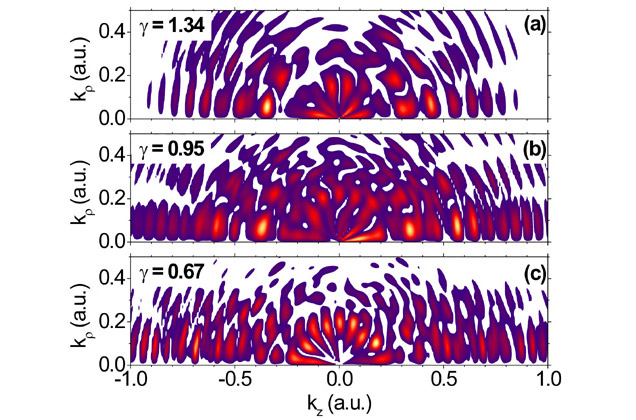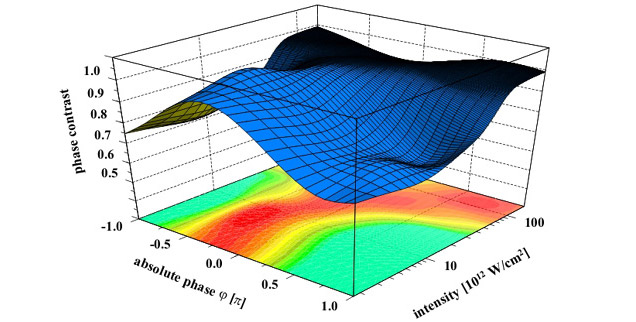Atomic theory, dynamic surface interactions, classical and quantum transport
Prof. J. Burgdörfer, Theoretical Physics, VUT
Main Research Areas:
Attosecond atomic dynamics, quantum chaos and classical-quantum correspondence, theory of open quantum systems, interactions of lasers and ions with clusters, surfaces, and solids.
Our research in the area of Advanced Photon Science focuses on the theory of the interaction of attosecond pulses with atoms, surfaces, and solids. Progress towards generation of ultrashort pulses on a time scale comparable to that of electronic dynamics opened up unprecented opportunities: matching the time scales and electronic motion and pulse duration allows one to monitor, control, and shape both atomic electrons and electromagnetic wavetrains. Extensions in several directions are planned: for a large number of overlapping resonances new features pertaining to open quantum systems are to be expected. Among them are wavepackets that mirror quasi-classical orbital motion and decohering wavepackets due to coupling to unobserved channels. Another direction is controlled rescattering of the electron driven by the optical field and monitoring the core excitation by an attosecond XUV pulse. The ultimate goal is coherent control of time-resolved atomic collisions.
Current projects address the time-resolved monitoring of coherent inner-shell dynamics in atoms. Advances in the generation of attosecond pulses allow the electronic wavepacket inside atoms to be tracked in real time. A recent proof-of-principle calculation showed that the time evolution of an isolated Fano resonance formed by coherent superposition of a Coster-Kronig resonance and a continuum state can be mapped out by an attosecond streaking technique in a pump-probe setting.
 Figure 1: P{Δ t}(E) as a function of the time delay between pump and probe pulse and observed in the direction of the polarization of the probe laser pulse. (a) Direct ionization with the resonant excitation suppressed (q=0), (b)-(c) autoionizing resonance with both pathways open (q=2.2) for different τr.
Figure 1: P{Δ t}(E) as a function of the time delay between pump and probe pulse and observed in the direction of the polarization of the probe laser pulse. (a) Direct ionization with the resonant excitation suppressed (q=0), (b)-(c) autoionizing resonance with both pathways open (q=2.2) for different τr.
Highly excited (''Rydberg'') atoms with very large principal quantum numbers n >> 1 allow to explore the border line between classical and quantum dynamics. They provide a unique laboratory for exploring classical-quantum correspondence, signatures of classical in quantum theory, and decoherence. We have developed classical and quantum descriptions for impulsively driven Rydberg atoms that can reach unprecedented quantum numbers up to n ≈ 300. A multitude of exciting opportunities of coherent manipulations arise, including the controlled transfer of the electron from one location to another inside an atom.
 Figure 2: Doubly-differential electron momentum distributions in cylindrical coordinates (kz,kρ). Frequency and duration of the laser pulse are ω=0.05 a.u., τ=1005 a.u. The Keldysh parameter is (a) γ=1.34,(F0=0.0377 a.u.), (b) γ=0.95, (F0=0.053 a.u.), (c) γ=0.67, (F0=0.075 a.u.).
Figure 2: Doubly-differential electron momentum distributions in cylindrical coordinates (kz,kρ). Frequency and duration of the laser pulse are ω=0.05 a.u., τ=1005 a.u. The Keldysh parameter is (a) γ=1.34,(F0=0.0377 a.u.), (b) γ=0.95, (F0=0.053 a.u.), (c) γ=0.67, (F0=0.075 a.u.).
The interaction of ultrashort laser pulses with condensed matter is another important research area of great potential technological relevance. We currently explore the surprisingly efficient generation of characteristic X-rays in large rare gas clusters indicating highly efficient heating mechanisms for electrons driven in nano-scale condensed environment. We have developed a stochastic mean field approach that allows the simulation of a large many-body system far from the ground state. Complementing these efforts, we are developing a time-dependent density functional theory (TDDFT) for fs-laser interactions with surfaces. TDDFT provides a workable route towards the study of linear and non-linear response of the many-body system to strong short-time perturbations. We have recently demonstrated the dependence of the total electron emission on the carrier-envelope (CE) phase of a 5-fs laser pulse in the multi-photon regime. Future investigations will address surface-induced harmonics, surface modication, and ablation.
 Figure 3: Computed charge emitted from a gold surface (modelled as a confined free-electron gas) exposed to a Gaussian laser pulse (λ0=750 nm, τ=5.5 fs) at grazing incidence as a function of CE phase φ and intensity. The light is incident with the electric field oriented along the surface normal ('P' polarization).
Figure 3: Computed charge emitted from a gold surface (modelled as a confined free-electron gas) exposed to a Gaussian laser pulse (λ0=750 nm, τ=5.5 fs) at grazing incidence as a function of CE phase φ and intensity. The light is incident with the electric field oriented along the surface normal ('P' polarization).
Contribution to IMPRS curriculum:
Atomic structure and dynamics
Lecturer: Joachim Burgdoerfer (3+1 hours/week)
Content:
Atomic structure calculations, strongly correlated systems, interactions with the radiation field and QED, atoms in strong fields, coherent excitation and density matrix description, open quantum system approaches: Monte Carlo wave function approach and quantum jumps, elements of quantum optics. S matrix for multi-channel problems. Analytic methods: perturbation theory and distorted-wave techniques; numerical techniques: coupled-channel approaches, R-matrix, wavepacket propagation, mean-field methods (time-dependent density functional theory). Applications to charged-particle atom scattering, photon-atom scattering, collisions of charged particles and photons with surfaces and solids
Non-linear dynamics and chaos
Lecturer: Joachim Burgdoerfer (2 hours/week)
Content:
Classical chaos in Hamiltonian and dissipative systems, introduction to quantum mechanics of chaotic systems, concepts for time-independent systems, random matrix theory and beyond, wavefunction correlation function and scars, semiclassical quantization, EBK and Gutzwiller; time-dependent systems: Floquet theory of driven systems, accelerator modes and quantum localization, relation to Anderson localization. Applications to atoms in strong static fields, atoms in laser fields, dynamics of Rydberg wavepackets.
